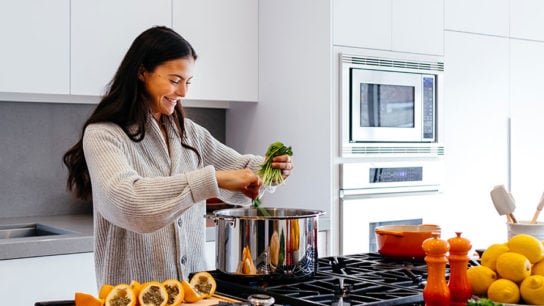Lockdown wasn’t easy on any of us the first time around. As we gear up for potential lockdowns amid recurring cases, here are my hard-learned lessons from the last one.
My name is Meghana and I’m a writer in Hong Kong. Having just graduated this summer, I’ve had my fair share of studying and working from home – both of which started off as exciting prospects, only for them to progressively worsen as the days dragged on.
While some countries have continued to bear the brunt of COVID-19, others have been lulled into a false sense of security, believing that the pandemic had been brought under control – only for a resurging wave of infections to take over. My home of Hong Kong falls into the latter category. While we were able to avoid the extreme lockdown measures introduced in parts of China, Europe, and the US, the city did come to a virtual standstill over the summer, with a third wave in August leading to tighter social distancing measures being introduced. These new rules included the limiting of public gatherings to two people, the cessation of dine-in services between the hours of 6pm and 5am, the mandatory wearing of masks in public spaces and when exercising, and a compulsory 14-day quarantine, amongst others.
While restrictions have since relaxed ever so slightly (masks are still mandatory, but groups of four are now permitted), there’s much talk of an incoming “fourth wave” of infection. And so, in an attempt to better prepare myself for a potential second round of self-isolation, I’ve jotted down the six lessons I learnt from my last time in lockdown at home.
1. Time management is essential, but it’s easier said than done
Glib as it may seem, this was one of the first things that struck me. As I spent the initial months of the pandemic cooped up in the little shack I call my room, I quickly found out how easy it can be to lose track of time.
As someone who’s always had a somewhat structured system on how an average day would go by, watching every system I had in place get obliterated during the lockdown period was unnerving, to say the least.
I would get distracted by the slightest noise and the fact that I was always at home rendered me rather complacent. To put it succinctly, my self-control was pitiful. Oftentimes, I would end up slogging after work hours to meet deadlines because I hadn’t been as productive during the day. I possessed this naive illusion of having more time than usual where even the most comprehensive of schedules couldn’t keep me from deviating.
After consulting countless time management guides and seeking out advice from peers who were evidently thriving during lockdown, l was finally able to settle into a routine that facilitated productivity to a decent extent – although it was definitely much harder than I had anticipated.
What worked for me was The Pareto Principle, otherwise known as the ‘law of the vital few’, which suggests that by doing 20% of the work, you can generate 80% of the benefit of doing the entire job. But time management, like most things, is not a one-size-fits-all kind of deal. To help you stay on track, consider one of these seven time management tools to help you meet those all-important deadlines.

2. Working from home isn’t always sunshine and rainbows
I was, like many others, excited at the idea of working from the comfort of my home. However, a few weeks in and all my preconceived notions of how I could be more productive when working in my pyjamas were firmly quashed.
The biggest bane of my WFH days? Poor WiFi connectivity. A number of instances come to mind where my face would freeze mid-sentence on a Zoom call – and don’t even get me started on file-sharing. This, coupled with persistent backache from my rather uncomfortable makeshift workspace, quickly burst my bubble about remote working.
Perhaps what I missed the most, though, were the extended coffee breaks at the pantry and the after-work chitchats. Working just wasn’t as fun without the sporadic diversions happening around the office or from my colleagues. Oh, and restaurants. How I missed restaurants.
You might also like 5 Key Factors to Consider When Choosing Your Work Environment
3. Virtual communication just doesn’t compare to face-to-face meetings
Going into lockdown, we had all the technology we needed to make virtual communication as – or nearly as – effective as face-to-face, but there were some moments when it became painfully obvious that they weren’t actually, in any way, the same.
Whatsapp, Slack, and, of course, email were my predominant go-tos for communication throughout lockdown. I’d throw in Houseparty video calls too, before security concerns quickly shut that trend down.
At first, everything went by smoothly – the introvert in me might have even enjoyed the circumstances a little. Feeling a semblance of human contact without having to be surrounded by people constantly was a win-win in my books. However, as time went by, the underlying hitches gradually came to light.
My messages weren’t always conveyed in the same manner I intended them to be. I was constantly conscious of not annoying my recipients by sending them long, rambly chunks of text, but also afraid of coming across as too curt. It would be an understatement to say that the WFH period sent my over-analysing tendencies into overdrive, with even the simplest of texts necessitating detailed scrutiny on my side, in order to decipher whether they are, in fact, being passive-aggressive or not. Needless to say, opportunities for miscommunication were pretty rife at the time, in spite of the numerous apps and platforms made available to us.
Regardless of my quibbles, we can’t deny that the future of workplace communication is going to be virtual, so I’d better get with the programme and adapt – fast. Through implementing minor tweaks to my style of communicating, toning down the over-analysis, and putting a little more effort into conveying my thoughts in a succinct manner, I should be good to go. And I’m pleased to report that I have made some headway in this, though the over-analysis part is proving somewhat harder to overcome, but que sera, sera.

4. Downtime will become a rarity if boundaries aren’t set
Proponents of remote working, more often than not, will often claim that working from home promotes higher productivity and better results. Quicker responses to emails, an unconscious willingness to work a little past office hours – these were just some of the habits I found myself indulging in while working from home. It just wasn’t as easy to shut down and leave once the clock hit six. Perhaps this was down to a need to “prove” how hard we were working – that we were not, in fact, slacking off, as some managers might have feared. Or perhaps it’s just harder to shut off when your office and bedroom are one and the same.
With the extended amount of quarantine-induced family bonding I was subject to, I also found it increasingly difficult to separate my domestic life and my work life. I was always either working or spending time with my family. Worse yet, there would even be moments when both these spheres would overlap. Without me even realising it, both these domains were slowly eroding into my “me” time.
The lesson here? If not well-defined, boundaries can get blurred pretty quickly when you’re under lockdown at home for drawn-out periods of time. Next time, I’ll be sure to create a dedicated workspace away from my areas for “down-time”. I’ll also establish firm rules with both my team and my family members, to ensure that my home life doesn’t spill into my work life, and visa versa. Finally, I’ll set boundaries for myself, allocating specific time for breaks – and make sure I stick to them!
5. Make self-care a priority. It’ll come in handy in the long run
The pandemic, in itself, is a stressful affair. Coupled with the self-isolation and the pressure of having to adapt to new normals, my mental health definitely took a turn for the worse.
In theory, I had all this time: I was free to do anything I wished, whenever I wanted to. Yet, putting myself ahead of all these seemingly important work-related priorities never seemed to make it on the agenda. With all that extra free time, I was either focused on making the most of this time to do something productive or to do absolutely nothing of value. Rarely, if ever, did I use that time to focus on my wellness.
In hindsight, squeezing in the occasional home workout and quick meditation session would have easily been doable, and would have probably made a big difference to my aforementioned frustrations. But taking time out for myself just somehow seemed to get lost amidst everything else that was going on in the day.
It can be difficult to get started with a self-care routine, but the results are well worth the effort. Take your pick of one (or more!) of these easy-to-implement self-care activities and take your well-being to the next level.

6. Self-improvement makes for a welcome distraction
My life during the months of lockdown, for lack of a better term, was orderly chaos. The TV blaring at full volume outside in the living room as I hopelessly tried to keep up with the heap of incoming messages on Slack/Zoom/Houseparty/Whatsapp/email (you get the idea…) was pretty much a daily occurrence throughout those months. As you can imagine, things got mundane pretty quickly, and I was constantly on the lookout for motivation to get me through the day.
It wasn’t long (or maybe it was) before I finally decided to jump on the self-improvement bandwagon. Teaching myself a new skill had always seemed like an intimidating prospect, but stepping out of my comfort zone was a welcome change compared to the humdrum I had found myself surrounded by. So I decided to start small and brush up on my Spanish – in the hopes that one day (after lockdown, of course) I could head over to Spain and test my skills out for real. Be it watching Spanish movies or going over my grammar notes from high school, I made sure to dedicate a little time from my day towards my newfound goal, thankfully breaking the monotony along the way.
If we are to go into another phase of lockdown, I’ll be sure to continue brushing up on my language skills, as well as my aforementioned virtual communication skills. I might even try my hand at coding, or look towards finding a new hobby like cooking or graphic design. Anything to break up the boredom and make good use of all that extra time at home!
Wrapping Up
Working from home was definitely not all that I imagined it to be. Though not all bad, the experience certainly left quite the impact. As I’ve slowly start getting back into the groove at the office, I can’t help but think how different things will be if we do go back into lockdown. Hopefully, though, the pandemic will subside and I won’t have to find out. In the meantime, I hope these musings have resonated with some of you, and helped perhaps a few.
Tired of working from home?
If you’re looking for a change of scenery, why not try out the Hive? Founded in 2012, the Hive is a leading coworking operator that offers flexible work solutions to businesses of every size, from freelancers to 100+ pax companies. Now with 20 locations in 7 countries across Asia Pacific, the Hive is the region’s widest and most recognised flexible workspace network – and might be just the place you need if WFH just ain’t cutting it.
So, if you want to get your productivity rolling, enjoy an ergonomic workspace, and connect with like-minded individuals, this might just be the place for you. Contact your nearest location for a free tour!
Locations: Australia | Hong Kong | Japan | Singapore | Taiwan | Thailand | Vietnam





